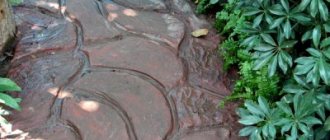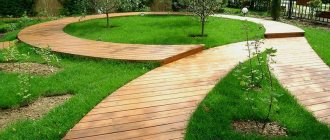The owner of a private house or cottage is trying to develop the surrounding area. And at the same time, it is important to make the site not only aesthetic, but also practical. Therefore, considerable attention is paid to garden paths. Fortunately, there are different options for garden paths. They differ in cost and production time, service life, appearance and complexity of the device. What can paths in the garden be made from? From almost everything. And we will briefly talk about the most interesting solutions in the article.
Path made of pallets in the garden
Are you planning to arrange wide paths in your dacha? And at the same time, do you have the opportunity to buy old pallets inexpensively? Then there is a great way to quickly and easily do the job yourself without spending extra money.
Of course, it won’t be possible without preparation – no one has canceled the marking and excavation work. But before laying the sand and gravel base, you will have to cover the bottom with geotextiles or roofing felt. They protect wooden pallets from moisture and prevent grass from growing on the path.
The pallets themselves also need to be prepared. First of all, look for damaged slats (if old pallets are used) - they need to be replaced. It might even make sense to disassemble one and use it as spare parts for the rest. In addition, do not forget to treat the entire surface with an antiseptic, and it is advisable to cover the lower bars with mastic - this will significantly extend the life of the track.
The rest of the installation is simple. The main thing is to ensure that the pallets are the same height and that there are no differences between them.
Along the edges of the future path around the dacha, logs with a section of 100x100 mm or 100x150 mm are laid. Pallets are placed on them, which are fixed using self-tapping screws. Thus, the pallets form a single path and will not move under load. As you can see, making them yourself is not difficult.
Video
Ideas
pallet track 1
pallet track 2
pallet track 3
Available materials
Garden paths can be made from scrap materials. If for certain reasons you do not like the above materials, then perhaps this option will suit you.
- We buy and install an air conditioner
- Do-it-yourself windmill - the best ideas and instructions for building decorative windmills in the garden and on the site (105 photos)
Do-it-yourself walk-behind tractor - how to make a simple and reliable homemade walk-behind tractor for farming (105 photos)
It's worth looking at what you have on hand. Some owners make their paths from old tires and bottles. Of course, it looks peculiar, but a job well done looks very attractive.
There are also gravel or crushed stone walkways. The main thing is to tighten them enough so that there is no discomfort while walking. If everything is done correctly, then this coating is convenient. Gravel conducts water well, so puddles will not form.
Tire track
However, it is not necessary to wait until the tires are recycled and you will have to pay a lot of money for the rubber track made from them. Some craftsmen make paths near their dachas from tires! You can get them at service stations and tire companies, and completely free of charge - the employees will even be grateful if you save them from unnecessary junk.
True, you will have to work hard with tires. First of all, they need to be cut into strips. If you plan to do this yourself, you need to know that you should cut along the edge - then the rubber will easily straighten and be even. After this, the tire is cut into strips of the required width. When enough material has been prepared, installation can begin. Of course, to do this you need to dig a place for the future path and arrange a cushion of sand and crushed stone. And on very heaving soils, you can also organize a cement screed. On normal soils you can do without it.
Now the tire belts themselves are leveled. To do this, they are nailed to slats or boards impregnated with an antiseptic or coated with waterproof mastic. Already in this position, a path is laid out of them. It is important to ensure that there are small gaps between the strips through which water can easily drain from the path, allowing it to dry quickly after rain.
Video
Ideas
garden path made of tires 2
garden path made of tires 3
garden path made of tires 4
Types of garden paths
Everyone who has a dacha and, albeit small, but their own personal plot, will think more than once about ways to decorate and transform it. There is not always enough finance to realize ideas and fantasies. Many will ask: “What should we do then?” The answer is quite simple: if you want to improve your garden paths, but you don’t have the money for a landscape designer or expensive components, then you should pay attention to available and more affordable materials.
To arrange garden paths with your own hands, various types of stones, boards, wood cuts, river pebbles and even plastic bottle caps will be useful. Now a little about each of the options.
Paths made of natural stone
They fit into any site design. They look natural, and if properly installed they can last for ages.
Such paths look very impressive. If there are stones left after the nearest construction, you can use them. Or those left over after laying the alpine slide will do. They have uneven shapes, which makes them ideal for a picturesque path.
Path made of natural stone
First you need to calculate the number of pebbles. One of the methods is rough placement of stones. This way you can estimate whether the amount of material you have is enough.
Sprinkle the area for the path with sand and compact it well. It turned out to be a kind of “pillow” for the pebbles. They need to be processed, adjusted to shape, and made more uniform. For good joining and grinding, you can use a grinder or other not very powerful types of tools. Having prepared the stones, they are placed in a mosaic composition.
Since all the stones are different in size, they are adjusted to each other using a rubber hammer. At least one side of the stone must be flat for the path to turn out as it should.
When the mosaic is ready, you need to start sealing the seams between the stones. Otherwise, they will begin to overgrow. Although some may prefer another option, the most natural one: a cement-sand mortar is used for grouting joints.
Concrete paths
They are very similar to stone ones. First make a bed, the depth of which is approximately 10 cm. Then pour sand on the bottom and compact it. Fill the top with a mixture of concrete and sand, install the formwork around the edges. Before the solution hardens, pour pebbles into it. Lay out your intended pattern from it. A drainage system must be installed next to such a path.
Sometimes a concrete path is made using a ready-made mold. It is easy to buy at a hardware store. And then just pour the concrete mixture into the mold in the place you need, level it with a trowel, remove the excess and remove the mold. This is a very easy and quick method, and besides, you can lay out this form in at least several rows.
How to make concrete paths with your own hands using ready-made forms
Wooden paths
Wooden paths will last a long time, but at the beginning they require maintenance. They can be laid out from sawn boards or timber, using what remains from the construction of the house.
Wooden paths
Prepare boards and blocks; the latter can be replaced with steel corners or pipes. Treat them with protective impregnations or bitumen mastic. After soaking, nail the boards to the blocks. Mount the path on top using hemp of various calibers. Paint them one or more colors.
But in domestic climatic conditions, the most modern impregnations will not protect the boards from deformation, rotting and corrosion, so imitation wood is often used as a material for paths - tiles with a corresponding pattern.
It will be possible to select such perfect samples that no one will detect the difference at a distance. It is felt only after tactile contact. The tiles reliably depict the natural texture of pine, beech, oak and other species in cross-section - as a result, the ersatz is indistinguishable from the original.
DIY gravel garden paths
Gravel is a simple material that has good flowability, allows moisture to pass through, and is relatively cheap. It can be used to make paths of any width and length, and perhaps even give them different shapes. This path looks neat and fits harmoniously into any landscape. Making it yourself will not be difficult.
DIY gravel garden paths
The order of execution of the gravel path
- First you will need to mark the path around the area. Marking is carried out with pre-prepared wooden pegs. You can stretch a string between the pegs if you find it difficult to determine the direction by eye.
- Next, according to the markings, prepare the bed. To do this, dig a trench in the ground. The depth of the trench can be about 14 – 17 cm.
- Prepare the gravel. It is advisable, if possible, to view it and remove unwanted impurities (broken glass, sharp large stones, etc.). Handling gravel should be done with thick gloves.
- Backfill gravel to the depth of the trench. You can level it with a rake or your hands (also use gloves).
- Next, the laid gravel is compacted.
- At the end, a curb stone can be laid along the edge of the path. This will give an even more impressive and finished look. The stone is secured with a cement foundation. It can be laid either flush with the canvas or slightly above it.
This algorithm is also suitable for constructing a sand garden path. Accordingly, gravel is replaced with sand, and then all work is carried out according to the same scheme.
DIY brick garden paths
This is a very fragile type of material. Before laying it is necessary to check for strength. First, mark the path using string and pegs.
Remove the soil (25 cm), place drainage underneath. In this case, it will be simple, but the main thing is that water does not penetrate. It is necessary to pour crushed stone on top of the drainage system. The boards are laid sideways along the edges. Then the brick is laid. You can come up with a wide variety of brick designs.
Clinker brick path
A garden path lined with brick chips looks great. It is also permissible to sprinkle it on a concrete path. Beautiful mosaics are made from broken bricks. If the bricks are of different colors, they are laid out in beautiful patterns. You can leave space between them to fill it with small stones, pebbles or soil, so that later there will be a green island there.
Homemade path made of brick and stone
Sandstone path
They are made dry or using cement pouring. This method is similar to laying a stone path, but the first one is more natural and original.
Dig a trench, removing part of the soil. Pour sand in there and compact it. The middle part should be higher than the edges. It is necessary to walk a little on the slope. This is a dehumidification system. Next comes the processing of the stones.
Sandstone can come in a variety of sizes and shapes. Try on each stone before cutting.
Level the stones, making the gaps as small as possible. The processed stones are laid out as you like. For a classic path you need a bucket of sand and the same amount of mixture with cement. Under each pebble you must first put the first one, then the second one. Moreover, the cement should protrude slightly. You need to press the stone tightly. The completed path must be washed so as not to spoil the aesthetics with cement residues. The seams are filled with soil or sand.
Path made from wood cuts
Such a path will look very beautiful and attractive.
Path made from wood cuts
The cuts must be taken of different sizes, laying them so that there is no free space between them. Before laying, round timber must be treated with an antiseptic composition.
Saw cuts for garden paths
Another option is to use round timber as borders and add a layer of gravel between them.
While staying at the dacha, you want to move away from city life, because all around, if not a forest, then a garden, some lucky ones even have a lake or river. In a word, no matter what the surrounding landscape is, it encourages you to get closer to nature.
An interesting idea is a path stylized as a forest one. It consists of fragments of ordinary tree stumps. Round plates of different sizes are laid along the edge of the pond and concreted.
The side of the artificial pond is made from them. It is pleasant to sit on such stumps to sunbathe; touching your feet with them also gives rise to positive sensations.
Plastic garden paths
Such country paths are sold as ready-made modules. Their installation does not require surface preparation or treatment. They are very easy and quick to install, very economical, and characterized by durability and long service life. They can be laid out on any site, in the form of any composition. They are environmentally friendly and aesthetically pleasing.
River pebble paths
Working with these pebbles will be difficult, time-consuming and will not end quickly. They are placed in a pre-limited space in wet sand and compacted to the required depth. The process takes several days.
River pebble paths
It happens that the design of country houses is based on imitation of the styles of past times - the ancient era, British classicism, etc. Then you should choose slabs ornamented in accordance with the general concept of the site and the residential building. They may have impressions of Mediterranean pebbles, ancient bricks, etc.
Paths made from plastic bottle caps
The most original and interesting way is to line the path or part of it with plastic bottle caps. Due to the fact that the lids have a variety of colors, you can create patterns and mosaics, even creating entire paintings.
The only disadvantage of this improvised material is its collection, because you will need a lot of lids.
Garden path made of reinforced concrete tiles
Stages of work:
Do-it-yourself ready-made garden path made of reinforced concrete tiles
Made from mosaic-type ceramic tiles
Paving stones, stone path
The slabs are laid on a layer of sand, and lawn grass is sown in the gaps. Mowing is carried out with a conventional electric lawn mower. The photo was taken 3 years after installation.
These are just the basic materials from which you can make country paths with your own hands. Human imagination is limitless, so by the next summer season they will probably come up with something else. Paths for dachas are made with your own hands from any, sometimes unexpected, material. For example, from glass bottles. You can create combinations of different types of material in one composition.
Remember that such paths carry not just convenience and benefit, but also beauty, pleasure for the eyes, and harmony. Imagine, invent, create.
Independently choosing materials for garden paths and the driveway to your dacha can sometimes be difficult. Then you just need to set aside time for a scrupulous study of catalogs or the means to consult with specialists. The result will justify all these costs.
Video master classes
At first my neighbor laughed at how I made garden paths, and a year later he came for the secret.
Read about annual flowers here.
Path at the dacha made of bottles
If we talk about budget paths at the dacha with your own hands, then it’s worth mentioning the option made from bottles. These can be plastic or glass bottles; some craftsmen lay out paths from plastic corks! Such paths are not afraid of temperature changes and high humidity, are durable and easy to use.
The bottles are pre-washed, cleared of labels and filled with water, sand or soil so that they do not deform under load. By the way, this is a great opportunity to get rid of the soil that appeared as a result of digging a trench - often there is nowhere to put it.
First, a trench is dug - the depth is about 30-40 cm. The bottom needs to be compacted and formwork built on the sides. Gravel, crushed stone or broken brick is laid at the bottom. Then there is a layer of geotextile or roofing felt - so that the grass does not grow and spoil the appearance of the path. A cushion of crushed stone and sand is poured on top of it. Bottles can be installed either vertically (neck down) or horizontally (neck towards the edge of the path). They are adjusted as closely as possible to each other. The gaps are filled with a mixture of dry cement and sand, and then watered with water from a watering can. Once the concrete has cured, you will have a strong, durable, cheap and attractive garden path.
Video
Ideas
Country house path made of bottles 1
Country house path made of bottles 2
Country house path made of bottles 3
garden path at the dacha made of bottles 4
Garden paths - how to combine beauty and convenience
A dacha, a private house, or a cottage require not only the arrangement of the interior and exterior, but also the embellishment of the area around it. Often owners want to combine practicality and aesthetics in one project. You can realize your idea by laying garden paths.
What you need to know and consider during construction
Any design begins with a concept, a thorough study of the area and a plan. The first step is to determine the directions, length, width of future paths, imagine their shape, decoration. Next, you need to analyze the bearing capacity of the soil in order to choose the right type of building material and only then plan.
You need to draw up a drawing on paper, there will be an opportunity to correct, redo, supplement. There are several important factors to pay attention to:
- The components must be resistant to environmental aggressiveness - high humidity, fungi, corrosion.
- It is good to tolerate temperature fluctuations of different seasons.
- Provide for a possible increase in loads (car, loaded wheelbarrow).
- The optimal angle of inclination of the canvas to avoid the accumulation of water from precipitation.
Advice from a landscape designer - in compact areas it is better to lay not straight garden paths, but with wavy bends and turns. This visually expands the space and deepens niches for plants.
Each owner decides what to build a path from independently, based on financial capabilities, needs and fantasies. Every coating needs a base. The ideal option would be a compacted earthen embankment or crushed stone cushion.
The most popular materials for DIY garden paths:
- A natural stone. It looks noble, aesthetically pleasing even with unsmoothed corners.
- Artificial substitute. The grace of nature, faceted by man.
- Clinker bricks will add bright colors to the garden.
- Gravel or large polished pebbles will provide originality.
- Wood is an affordable, simple, but short-lived look. Looks impressive separately and in a composition.
- Decking is garden plastic parquet. New material, resistant to ultraviolet radiation, water, mold, rot.
The decorative effect of the structure largely depends on the methods of laying the blanks. The canvas can be solid, smooth, or consist of separately located elements of different geometric shapes. By laying out a path of large “leaves”, “butterflies”, “flowers”, it is easy to enjoy the comfort and pleasant walk.
Manufacturing
The production of garden paths directly depends on the selected material. And, accordingly, the base is also determined by the coating. It is easier to make a path from some materials, for example, from concrete, from others it is more difficult, for example, from pebbles. But, if you want this particular material, then any difficulties will be completely unimportant for you.











